
Bath is the largest city in the county of Somerset, England, known for and named after its Roman-built baths. In 2011, the population was 88,859. Bath is in the valley of the River Avon, 97 miles (156 km) west of London and 11 miles (18 km) southeast of Bristol. The city became a World Heritage site in 1987.
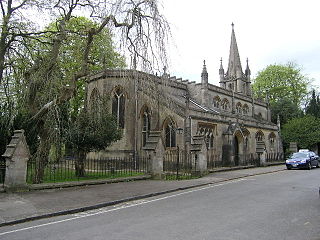
Combe Down is a village on the outskirts of Bath, England in the Bath and North East Somerset unitary authority within the ceremonial county of Somerset.
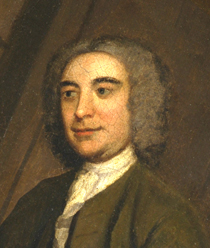
John Wood, the Elder,, was an English architect, working mainly in Bath.

Clutton is a village and civil parish on the eastern edge of the affluent Chew Valley, close to the Cam Brook river, in the Bath and North East Somerset Council area, within the ceremonial county of Somerset, and straddles both the A37 and A39. It is located 9 miles (14 km) from Bristol and Bath, and 11 miles (18 km) from Wells. Nearby are the villages of Temple Cloud, High Littleton and Chelwood. The town of Midsomer Norton is 5 miles (8 km) away. The parish, which includes the hamlets of Clutton Hill and Northend has a population of 1,602.
James Wilson (1816–1900) was a prominent Victorian architect practising in Bath, Somerset and partner in the firm Wilson & Willcox.
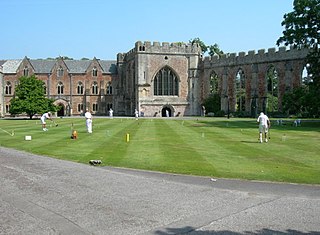
The Bishop's Palace and accompanying Bishops House at Wells in the English county of Somerset, is adjacent to Wells Cathedral and has been the home of the Bishops of the Diocese of Bath and Wells for 800 years. It has been designated by English Heritage as a Grade I listed building.
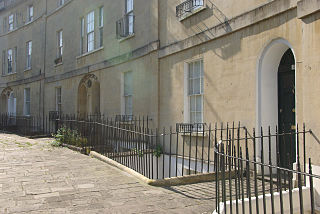
Widcombe is a district of Bath, England, immediately south-east of the city centre, across the River Avon.

Fore Street in Chard, Somerset, England was built in the late 16th and early 17th century, following a fire which destroyed much of the town in 1577.

The Octagon Chapel in Milsom Street, Bath, Somerset, England was built in 1767 and has been designated as a Grade II* listed building.

Gay Street in Bath, Somerset, England, links Queen Square to The Circus. It was designed by John Wood, the Elder in 1735 and completed by his son John Wood, the Younger. The land was leased to the elder Wood by Robert Gay, MP for Bath, and the street is named after him. Much of the road has been designated as Grade I listed buildings.

Duke Street in Bath, Somerset, England was built in 1748 by John Wood, the Elder. Several of the buildings have been designated as Grade I listed buildings. The street, which overlooks the River Avon, is pedestrianised with no vehicles permitted to enter.

North Parade in Bath, Somerset, England is a historic terrace built around 1741 by John Wood, the Elder. Several of the houses have been designated as Grade I listed buildings.

South Parade in Bath, Somerset, England is a historic terrace built around 1743 by John Wood, the Elder. All of the houses have been designated as Grade I listed buildings.

Stall Street in Bath, Somerset, England was built by John Palmer between the 1790s and the first decade of the 19th century. The buildings which form an architectural group have listed building status and are now occupied by shops and offices.

Bathwick Hill in Bath, Somerset, England is a street lined with historic houses, many of which are designated as listed buildings. It climbs south east from the A36 towards the University of Bath on Claverton Down, providing views over the city.

Cheap Street in Bath, Somerset, England is adjacent to Bath Abbey and contains several listed buildings.

Kingsmead Square in Bath, Somerset, England was laid out by John Strahan in the 1730s. Many of the houses are listed buildings.

Trim Street in Bath, Somerset, England is a historic street, built in 1707, of shops and houses, many of which are listed buildings. It was named after George Trim who owned the land.

Upper Borough Walls is a historic street in Bath, Somerset, England. Many of the structures are listed buildings.
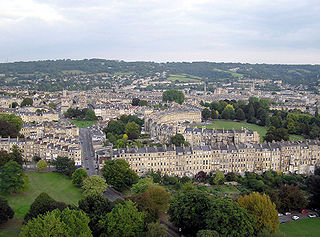
The buildings and architecture of Bath, a city in Somerset in the south west of England, reveal significant examples of the architecture of England, from the Roman Baths, to the present day. The city became a World Heritage Site in 1987, largely because of its architectural history and the way in which the city landscape draws together public and private buildings and spaces. The many examples of Palladian architecture are purposefully integrated with the urban spaces to provide "picturesque aestheticism". It is the only entire city in Britain to achieve World Heritage status, and is a popular tourist destination.




















